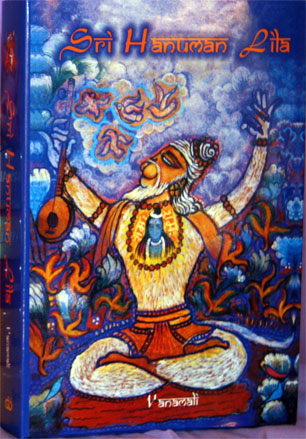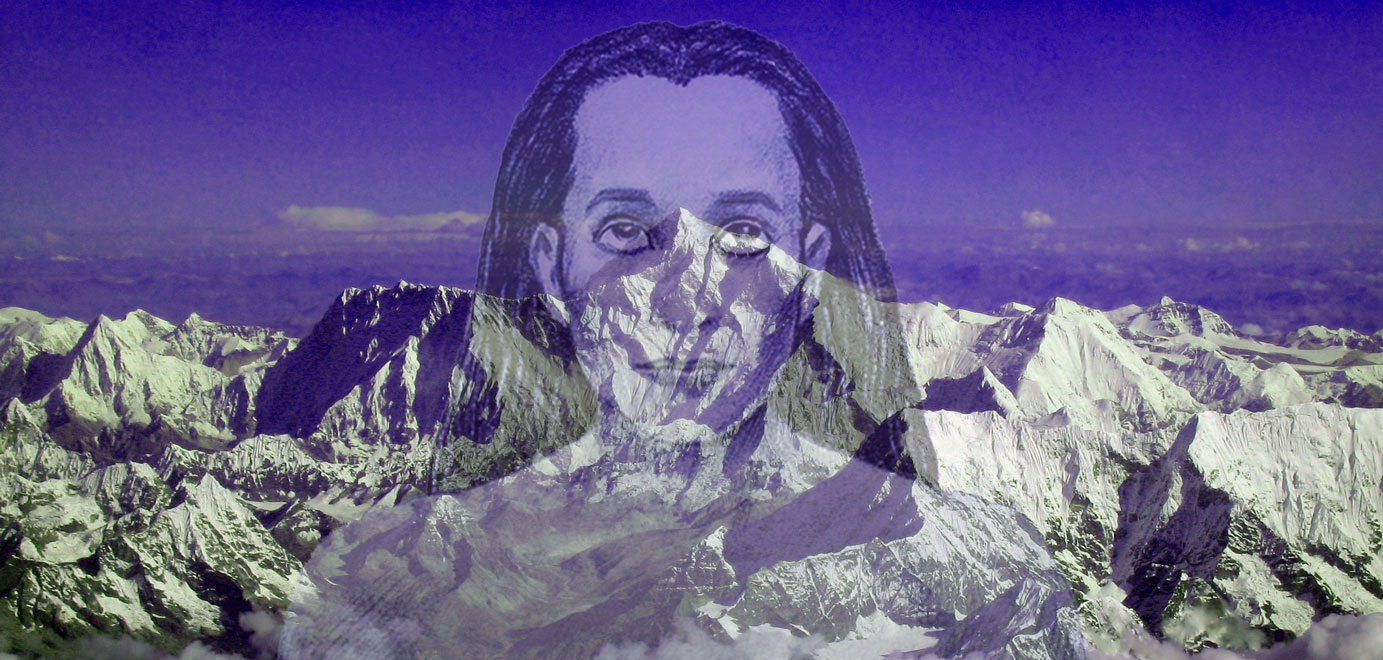 MAHAVATAR BABAJI The legend of the great siddha, Mahavatar Babaji, who has been living for hundreds of years in the Himalayas and still looks like a youth, is one which has inspired many people to search for him. (A siddha is a perfect human being possessing extraordinary powers.) He came to the public eye with the book written by Paramahamsa Yogananda, called, “Autobiography of a Yogi”, in which he revealed the existence of this great yogi who had given initiation to his guru’s guru, Sri Lahiri Mahasaya in a cave in the Himalayas. Very little is known about his previous life. What little we know is from the revelations given by Babaji himself to S.A.A Ramaiah, who was a student of geology at the University of Madras and Sri V.T Neelakantan who was a journalist. Babaji appeared to them independently and brought them together in order to work for his mission in 1942 and revealed little bits of his early life to them. He is supposed to have been born on November 30th, 203 AD in a small coastal village, known as Parangipettai in Tamil Nadu. He was given the name of Nagaraja or the “serpent king”. This is a common name in Tamil Nadu but it could also be a portent of his future prowess in mastering the “kundalini shakti” which is referred to as the “serpent power”. He was a most unusual boy and was obviously an adept in the practice of the Kundalini Yoga from a previous life. His father was the priest of the temple of Muruga or Kartikeya, next to their house. He obviously prayed to Kartikeya to be born as his son. In answer to his prayers, the Lord took birth as his son, Nagaraja. Kartikeya is the eldest son of Lord Shiva. He is worshipped under many names – Muruga, Subramanya, Shanmuga, Skanda etc. His temples are found more in the South of India than in the North. 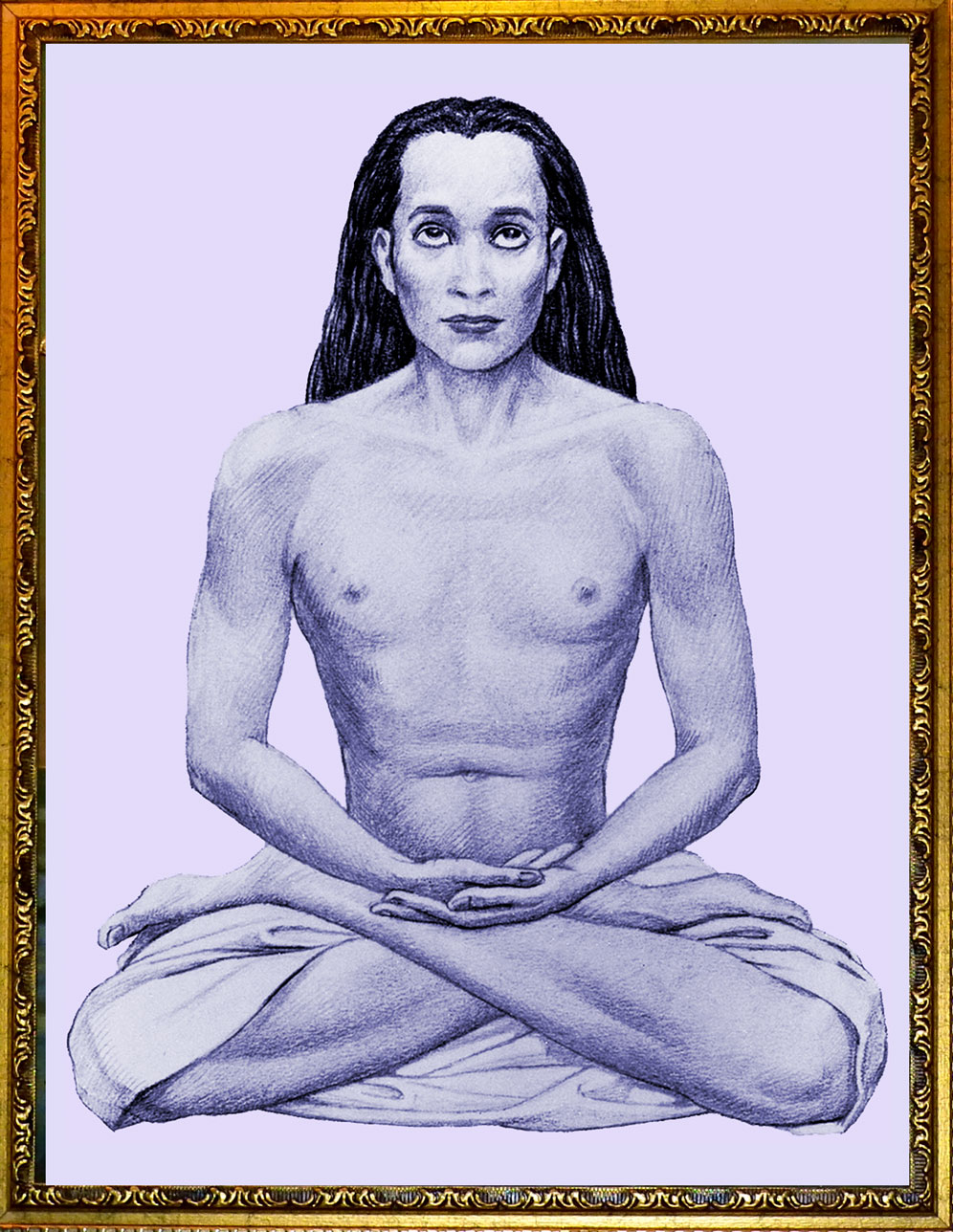 Mahaavatar Babaji- A drawing from Autobiography of a Yoga Commisioned by Swami Yogananda and based on his own meeting with Babaji! When Nagaraja was 5 years old, it is said that someone kidnapped him and sold him as a slave to a shopkeeper in Calcutta. His owner however was a kind man and released him and told him to go where he wanted. The boy joined a group of wandering yogis who had great love for God. The radiance in their faces attracted him so much that he followed them wherever they went. For the next ten years he wandered around the sub-continent with them, studying all the Holy Scriptures of Hinduism like the Vedas, Upanishads and the Puranas. At the age of 15 he went with the ascetics right down to southern coast of India to the village called Dhanushkodi which is the place which is closest to the island of Sri Lanka. From there the party crossed by boat to Sri Lanka and made their way on foot to the holy city of Kartargama in the north of the island. It was a most difficult journey in those days and only yogis could find their way to this holy shrine but the boy Nagaraja had no difficulties. He knew that he had to go there for it was the place where he had incarnated in a previous life. Katargama is a divine place visited by all the great siddhas. It is known as Dakshina Kailasa or the Kailasa of the south. Kailasa is the abode of Shiva in the Himalayas. Strangely enough these two places lie on the same line of longitude 80.10 degrees east - Kailasa in the extreme north and Katargama in the extreme south. This line is said to refer to the sushumna nadi or subtle nerve centre that runs through the human spine. All the chakras or subtle centres of psychic energy are located along the spine. Kailasa corresponds to the Sahasrara Chakra or the thousand petalled lotus situated over the fontanel on top of the head in the human being, while Katargama is the Muladhara Chakra situated just above the anus in the human body. All those who wish to practice Kundallini Yoga have to enter through the Muladhara Chakra. 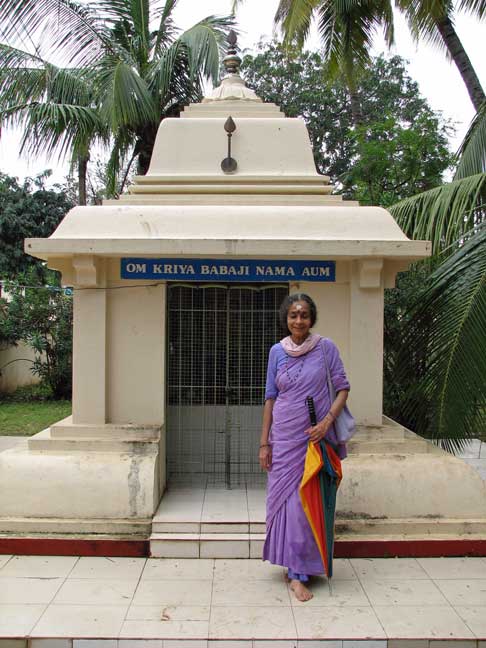 Mataji at Babaji Shrine Katargama Katargama was the name of Lord Subramania when he incarnated himself at that place. But strangely enough there is no icon or idol of Subramania here. His aspect as pure consciousness alone is worshipped here. The main temple has two apartments. The sanctum sanctorum contains a small casket with the shat-kona yantra, which is a mystic design with two interlocking triangles. It is heavily veiled with seven curtains. It does not have an idol of Kataragama (Subramania). Instead it has a casket, which contains the mysterious yantra (mystic diagram), which is embossed on a golden tablet studded with gems. This is where the divine power is supposed to reside. The Lord in his nada bindu form (form of letters and sound) is enshrined in the yantra. 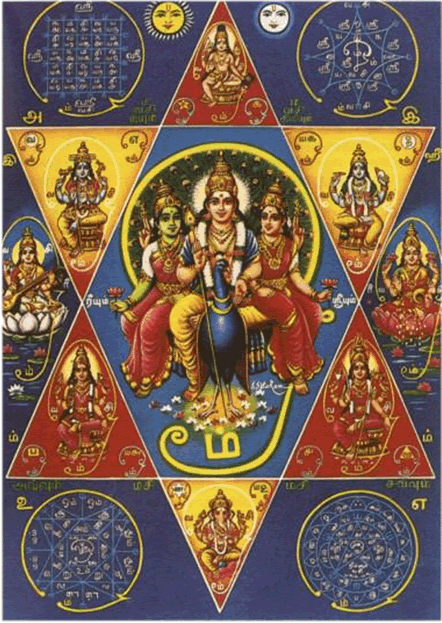 Lord Subramania Yantra Till very recent times the only way to reach Kataragama was by foot. The path led through thick equatorial jungle, infested with snakes and wild animals. Only the intrepid and the faithful could make this hazardous journey and return home alive. Now of course the town has been connected by road to all major cities of Sri Lanka so most people prefer the safer method of going by some motor vehicle. However even today there are a few people who still follow this ancient trail and go on foot. The Tamil Hindus make a yearly pilgrimage from the south of Sri Lanka right up to the temple of Katargama. They believe that the pilgrimage to Kataragama is feasible only if Lord Muruga himself issues an invitation. I was truly fortunate to have got this invitation. Ten years ago something drove me to make the attempt to go to this magic place where Babaji had been initated. At Katargama, Nagaraja met his guru, Bhogarnatha. This is why he had been led to this place. He performed intense sadhana for a long time with him. Bhogarnatha who was a great siddha, conferred many powers on him including the secret of “Kaya Kalpa” or the method of preserving the body in a youthful state for thousands of years. This is how Babaji still looks like a young boy even though he is centuries old. 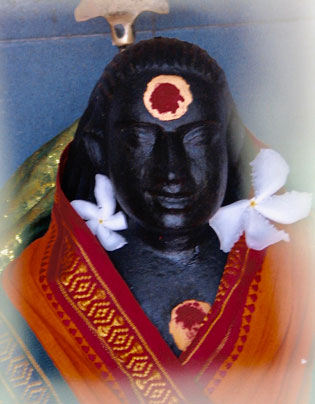 Katargama has a shrine dedicated to Babaji.
This is his idol in Katargama. Bogarnatha then directed him to go to Coutrallam in Tamil Nadu where the great sage Agastya was living incognito. Agasthya was one of the seven sages who had been sent by Lord Shiva himself to revive the knowledge of the Sanatana Dharma in the south of India. Nagaraja went and sat with him without knowing who he was. Seeing his deep potential, Agastya revealed himself and initiated him into the Kriya Kundalini Pranayama also known as “vasi yogam”, which is a most powerful breathing technique for attaining higher states of consciousness. After he finished his course of study, the sage advised him to go to the famous Himalayan temple known as Badrinatha. ( In the Srimad Bhagavad Purana, when Lord Krishna decided to drop his body, he advised his friend and disciple Uddhava to go to Badrinatha. Krishna told him that after he left his body, he could be found only in Badrinatha. This temple is in the high regions of the Himalayas on the banks of the Ganga known as Alagananda. There is a hot spring close to it and yogis sit around it during winter when the temple and the rest of the places around is snow bound. It is a place which is filled with holy vibrations. The idol of Lord Vishnu which is found there has an uncanny resemblance to Babaji. There is also a painting of a yogi in this temple which closely corresponds to the descriptions we have of Babaji. I have met people who live there the year round who claim to have seen this half naked yogi roaming around the mountains.) Nagaraja followed his guru’s advice and went to Badrinatha where he earnestly started to practice all that he had learnt from both his gurus –Bhogarnatha and Agastya. For many years he lived alone in a cave practicing the yogic techniques that had been taught to him until he became a true siddha – a perfected soul who had mastered both his body and the elements and had merged into the infinite, supreme power that resided in him as well as the universe. He came to be known Baba Brahmananda. Babaji had many great disciples out of which Lahiri Mahasaya is the one known to most people since he has been mentioned in the famous book, “The Autobiography of a Yogi”, by Paramahamsa Yogananda. His meetings with Babaji took place between the years 1861 and 1935. It was in the year 1861 that Babaji taught him a powerful series of yogic techniques known as “Kriya Yoga. This was taught in the cave which is now known as Babaji’s cave, near Dwarahat in the Kumaon District of Uttarakhand. Lahiri Mahasaya later taught the technique to his disciple Yukteswara who taught it to Paramahamsa Yogananda who mentions in his book that he was given the order to go to the west and teach the technique to the westerners by Babaji himself. Another great disciple was Devendranath Tagore, the father of the famous Rabindranath Tagore, who professed to having spent quite some time with Babaji in the Himalayas. He also sent his son Rabindranthath Tagore, when he was in his teens to live with Babaji for three years. Most people think that Babaji taught only Kriya Yoga. This is not so. Two of his disciples contradict this. The renowned Bengali saint known as Vijay Krishna Goswami, of the Vaishnava tradition was also a disciple. He admitted that Babaji was the one who had revealed the famous Maha Mantra to him which is found in the Kalisantara Upanishad. This is the 22- syllabled mantra of Krishna which was taken to the west by Sri Prabhudananda and is used by all the Hare Krishna groups and of course by many others as well.  “Hare Rama, Hare Rama, Rama, Rama Hare Hare,
Hare Krishna, Hare Krishna, Krishna, Krishna Hare Hare.” Sri M, author of “Apprenticed to a Himalayan Master”, narrates that he met Babaji near the hill of Neelkant. He describes him as being a golden complexioned, bare-bodied person with flowing brown hair that fell to his shoulders. He was clad in a shining white loin cloth that barely reached his knees . A divine perfume emanated from him. To him Babaji appeared to be like Shiva. Another of Babaji’s famous disciples was Neem Karoli Baba who is supposed to have been an incarnation of Hanuman. Actually Babaji has several caves associated with him. One of these is located in a dense forest populated with tigers and other fierce animals. If anyone gets lost in that forest at night, one of Babaji’s disciples comes and leads him to the cave. People have different experiences in this cave depending on their mode of life. Poor people find it to be sparse and bare, middle class people find it to be furnished very simply and extremely rich people find it luxuriously furnished with carpets, and ornate furniture. Each one is given the type of food he or she is accustomed to. In the morning one of Babajis’s disciples shows the way out of the jungle. Of course I too was inspired by all these stories and even more inspired by meeting a friend who said that he always visited her at night. She used to keep a glass of water for him and she said that in the morning the glass was empty. Recently I was instigated to make a visit to Babaji’s cave near Dwarahat. It was indeed a unique experience. We had already made one climb to the temple of Dunagiri Devi, so the next climb to the cave was really a great effort for me. Babaji’s cave is kept under lock and key by the Yogoda society. They open it only from 11 am to 2 pm in the afternoon. It was well past one by the time we reached the cave so there was very little time to sit and meditate. 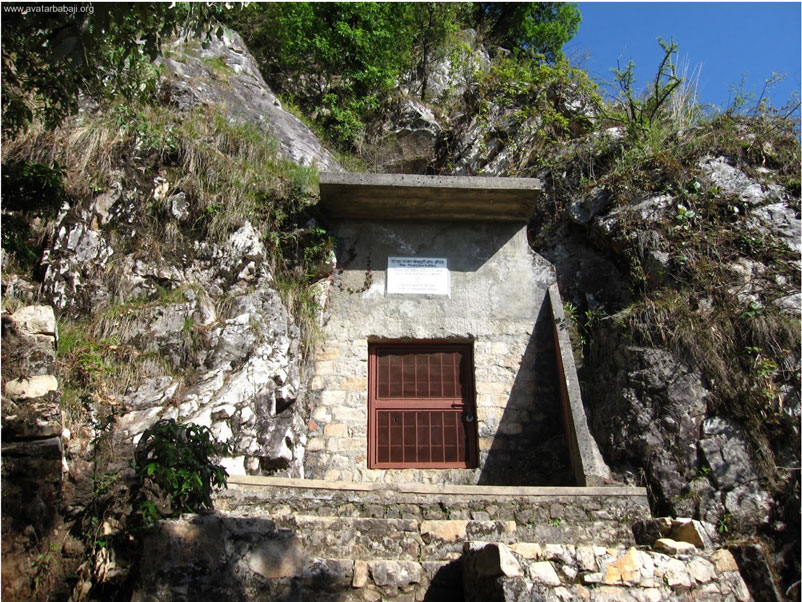 Babaji’s cave near Dwarahat 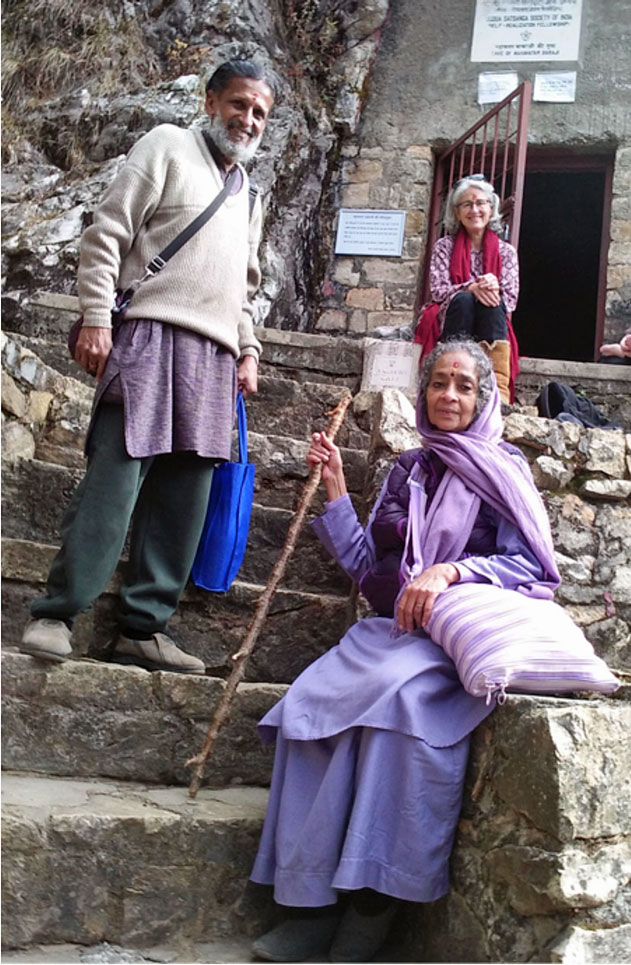 Mohanji, Julie and Mataji outside Babaji’s cave. When we reached the cave, there was an American sitting outside and another bare bodied Indian meditating inside the cave. I went and meditated for some time and was transported to a no-man’s land where time ceased to exist. Even though I had no cushion and was sitting on the bare rock floor I felt no discomfort and would have kept on in that meditative state for a long time. The voices outside brought me back to my normal consciousness. I opened my eyes. The man who had been meditating inside had gone outside and was talking to my brother. Reluctantly I too got up and went outside. I looked at the man and asked, “What is your name?” He answered, “Bala Subramaniam!” 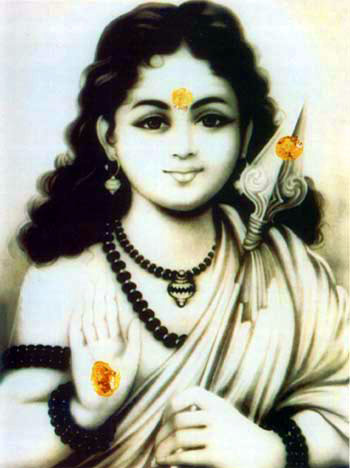 Bala Subramaniam
I burst into laughter when I thought of the Lord’s leelas! (play). Everything clicked into place. So many things had happened which had been woven through the tapestry of my life to bring me to this point. Of course it was He who had taken me to Katargama and who had brought me now to his cave. I basked in the revelation. Even though I could not see him, I felt his presence everywhere. We sat for a while and then started back. I had been dreading the climb back to civilization. But as I started to go down, my heart filled with joy when I thought of the divine child brandishing his spear in the air, running in front of me all the way up. Unbelievably the journey back hardly took half an hour. Before I knew it, we were back at the little hut where lived a couple whose sole source of income was to make tea for all who went to the cave and returned, weary and blissful. Everything looked perfect, the little thatched hut and the calf with the beautiful knowing eyes gazing at me in wonder, the dog hovering at my feet in the hope of a titbit, the man chewing tobacco and his wife offering steaming cups of tea! 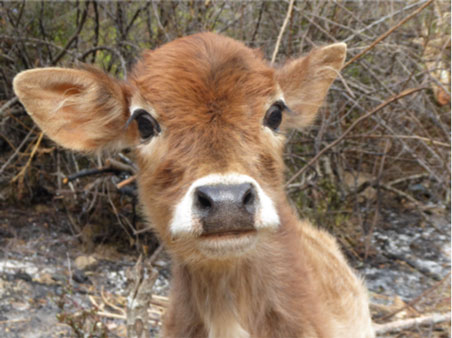 The calf with the wondering eyes. Aum Muruga! |
|
